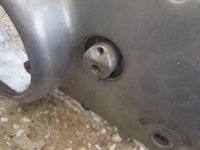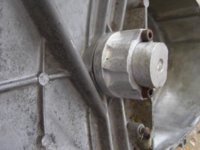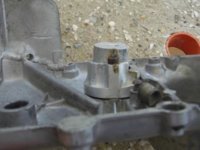Metal
XS650 Custom shop
Mr Riggs and I have been messaging and he used a square o ring suitable for mineral oil.



Once again thank you for your time.
I have made my own measurements Mr Riggs and I can see what you're talking about. Space is limited.
Did you take your cylinder bore depth measurement from the original worm drive mechanisms total lenght or did you arrive at another measurement based on some other restraint?
Dan

Yes I think you are correct but the piston in my design is only 19mm high so it is in my best interest to minimize freeplay so I'm not wasting stroke to adjust out the free play... By using an adapter that is easily removable I should be able to tweak the engagement so there is minimal free play... Thats my theory...LOL great to see I'm on the right track. Looks like you have done a fine job on this. Please let me know how you do next week.
Forgive my lack of understanding but wouldn't bleeding the system prime the piston to a perfect fit? Much like bleeding slave cylinder on your disc brakes.
Thanks for the xs650 engine. I'm sure it will be handy in the future.
Pago, by sticking wires and prodding with welding wire etc I was able to guess somewhere around 12mm or so... So I'm hoping your math is correct...Cool Beans!
So to put some numbers on this, as I'm a numbers kind of guy, the 12.9mm MC combined with a 28mm slave will provide a movement ratio of (12.9/28)*(12.9/28) = 0.21. So if the MC piston moves 1/2" (call it 13mm), you will get (0.5*0.21) = 0.10" (2.7mm) clutch plate movement.
From here (http://xs650temp.proboards.com/thread/17567/bolt-on-hydraulic-clutch-conversion)
I believe Mr. Riggs numbers were using a 9.5mm Magura MC with 13.8mm travel, and a 1" (25.4mm) slave. This yields a movement ratio of 0.14, and a clutch plate movement of 1.9mm.
That's over a 40% difference - BUT I CANNOT CONFIRM THE 12.9MM MC PISTON TRAVEL. From the same thread, another gent measured the stock pulley-screw measurement at 2.08mm.
I would assume (that word has bit Me in the butt more than once...) that the 2.7mm clutch plate movement would assist finding neutral a little easier, but would also have a stiffer pull?

Just an FYI for you guys. My current pressure plate displacement is 0.050" (1.25mm). In all my clutch worm and cable experiments, I don't think I ever exceeded 0.058" (1.5mm) of pressure plate displacement...



